Age related prevalence of hand osteoarthritis diagnosed by photography (HOASCORE)
- PMID: 29197369
- PMCID: PMC5712087
- DOI: 10.1186/s12891-017-1870-0
Age related prevalence of hand osteoarthritis diagnosed by photography (HOASCORE)
Abstract
Background: Hand photography has been used in a number of studies to determine the presence and severity of hand osteoarthritis (HOA). The aim of this study was to present age and gender specific prevalences of HOA diagnosed by this method.
Methods: Six thousand three hundred forty three photographs (from 3676 females and 2667 males aged 40-96) were scored for hand osteoarthritis by a 0-3 grade (0 = no evidence of OA, 1 = possible OA, 2 = definite OA and 3 = severe OA) for each of the three main sites, distal interphalangeal joints (DIP), proximal interphalangeal joints (PIP) and thumb base (CMC1). An aggregate score of 0-9 was thus obtained (HOASCORE) to reflect the severity of HOA in each case.
Results: DIP joints were most commonly affected, followed by the thumb base and the PIP joints. Having definite DIP joint OA starts at a younger age compared with the other two sites, and there is a marked female preponderance in the age groups from 55 to 69, but after 70 the gender differences are less marked and the prevalence is fairly stable. PIP joint prevalence also indicates a female preponderance from 60 to 79. Thumb base OA has a more marked female preponderance and a rising prevalence thoughout life. The prevalence of individuals with no evidence of photographic OA (HOASCORE = 0) drops from 88% to 57% between the age categories 40-49 and 50-54 and decreased to 33% in the 70-74 age group with a slower decline after that age. DIP and PIP prevalence were strongly associated with each other with an OR of 16.6(12.8-21.5),p < 0.001 of having definite OA at the other site. This was less marked for the thumb base with an OR of 2.2(1.8-2.7, p < 0.001), and 2.7(2.0-3.5, p < 0.001) of having definite DIP or PIP HOA respectively.
Conclusions: The prevalence of hand OA in DIP, PIP and thumb base joints obtained by the photographic HOASCORE method is higher in women and increases after the age of fifty. These results are in line with those obtained by clinical examination and radiography. The advantage of the method lies in easy applicability and low cost.
Keywords: Diagnosis; Epidemiology; Hand osteoarthritis; Photography.
Conflict of interest statement
Ethics approval and consent to participate
Both studies were approved by the Icelandic National Bioethics Committee, (VSN: 00–063, and VSN 09_098_S1) and the Data Protection Authority. All participants signed an informed consent declaration.
Consent for publication
N/A
Competing interests
The author declares that he/she has no competing interests.
Publisher’s Note
Springer Nature remains neutral with regard to jurisdictional claims in published maps and institutional affiliations.
Figures
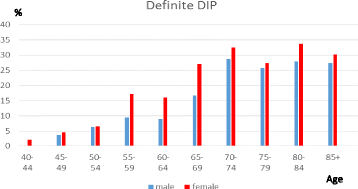

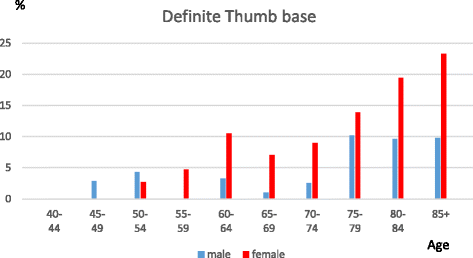
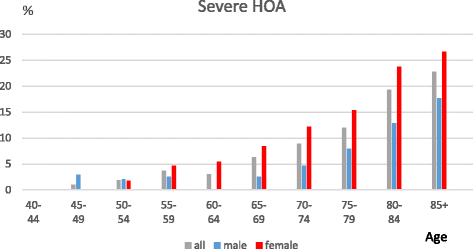
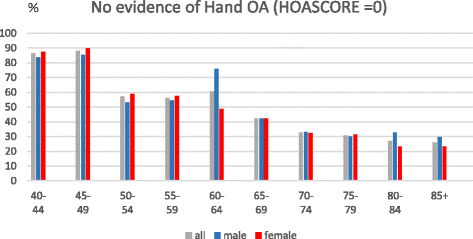
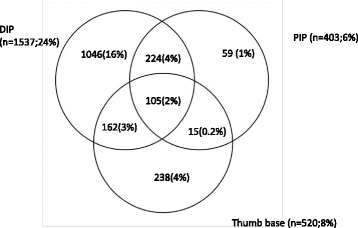
Similar articles
-
Reliability of Assessing Hand Osteoarthritis on Digital Photographs and Associations With Radiographic and Clinical Findings.Arthritis Care Res (Hoboken). 2014 Jun;66(6):828-36. doi: 10.1002/acr.22225. Arthritis Care Res (Hoboken). 2014. PMID: 26259552 Free PMC article.
-
Joint-specific prevalence of osteoarthritis of the hand.Osteoarthritis Cartilage. 2006 Sep;14(9):953-7. doi: 10.1016/j.joca.2006.04.013. Epub 2006 Jun 8. Osteoarthritis Cartilage. 2006. PMID: 16759885
-
The use of digital photographs for the diagnosis of hand osteoarthritis: the AGES-Reykjavik study.BMC Musculoskelet Disord. 2012 Feb 16;13:20. doi: 10.1186/1471-2474-13-20. BMC Musculoskelet Disord. 2012. PMID: 22340303 Free PMC article. Clinical Trial.
-
[Hand osteoarthritis].Cas Lek Cesk. 2016 Fall;155(6):305-309. Cas Lek Cesk. 2016. PMID: 27917634 Review. Czech.
-
Hand osteoarthritis: an epidemiological perspective.Semin Arthritis Rheum. 2010 Jun;39(6):465-76. doi: 10.1016/j.semarthrit.2009.03.001. Epub 2009 May 31. Semin Arthritis Rheum. 2010. PMID: 19482338 Review.
Cited by
-
Comparison of Prevalence of Osteoarthritis in the Hand: A Multicenter Retrospective Cohort Study.J Hand Microsurg. 2020 Sep 9;14(4):284-291. doi: 10.1055/s-0040-1715927. eCollection 2022 Oct. J Hand Microsurg. 2020. PMID: 36398154 Free PMC article.
-
Orang Asli Health and Lifeways Project (OA HeLP): a cross-sectional cohort study protocol.BMJ Open. 2022 Sep 20;12(9):e058660. doi: 10.1136/bmjopen-2021-058660. BMJ Open. 2022. PMID: 36127083 Free PMC article.
-
Longitudinal validity of using digital hand photographs for assessing hand osteoarthritis progression over 7 years in community-dwelling older adults with hand pain.BMC Musculoskelet Disord. 2019 Oct 27;20(1):484. doi: 10.1186/s12891-019-2829-0. BMC Musculoskelet Disord. 2019. PMID: 31656178 Free PMC article.
-
Elektra prosthesis versus resection-suspension arthroplasty for thumb carpometacarpal osteoarthritis: a long-term cohort study.J Hand Surg Eur Vol. 2020 Jun;45(5):452-457. doi: 10.1177/1753193419873230. Epub 2019 Sep 11. J Hand Surg Eur Vol. 2020. PMID: 31510855 Free PMC article.
-
Platelet-rich plasma for thumb carpometacarpal joint osteoarthritis in a professional pianist: case-based review.Rheumatol Int. 2019 Dec;39(12):2167-2175. doi: 10.1007/s00296-019-04454-x. Epub 2019 Oct 14. Rheumatol Int. 2019. PMID: 31608418 Review.
References
Publication types
MeSH terms
LinkOut - more resources
Full Text Sources
Other Literature Sources
Medical
Molecular Biology Databases

